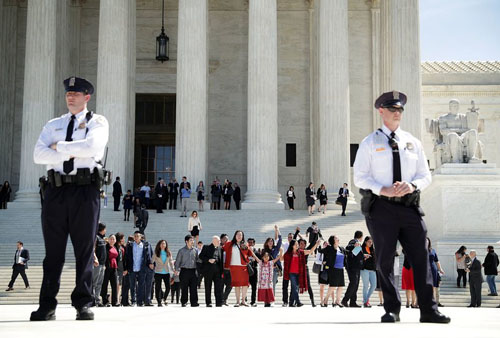美國的移民法院體系深陷麻煩亟需改革

|
自從特朗普2016年當選以來,他對美國移民體系的改革力度可謂史無前例。美國的移民審查執行辦公室(EOIR)差不多已經成了一臺移民遣返機器。而且美國移民執法力度的增長速度已經超過了EOIR自身的增長速度,造成了大量案件積壓。而給移民法官下達“辦案指標”,只會繼續加劇這一亂象。 據說美國移民法院體系中現有70萬件積壓案件,人人都能看出美國的移民法院體系出現了危機。新的“辦案指標”制度要求法官平均每天至少要審理三件移民案件,也就是說,每名面臨遣返的移民只有不到兩個小時的時間為自己辯護。在這么短的時間內,法官是否能夠仔細審查證據,給出公平公正的裁決,恐怕要畫一個大大的問號。 很多移民案件的裁決,說關乎人的生死,也不為過。對于這些人,他們擁有舉行一次充分公平公正的聽證會的權利,但這樣的聽證會在兩個小時里能開完嗎?可是每超時一分鐘,法官離被摘帽子就近了一步,在這樣的壓力下,他的裁決難道不會受到影響嗎? 去年1月,特朗普放棄了之前在移民執法領域較為明智的做法。他將移民執法的目標從犯罪分子和危害國家安全人員轉移到了幾乎所有人身上。去年,美國移民部門逮捕的非罪犯移民增長了一倍以上。我估計,今年有更多與美國有深度聯系的人已經上了被驅逐的名單,而他們本來有充分的理由留在美國,而且就算走正常法院流程,也不會被驅逐得如此之快。 2017年春季和夏季,美國開始大張旗鼓在美墨邊境遣返移民,全國各地的法官都不得不暫時拋開手頭的工作,被抽調去搞這個“遣返專項行動”,這也使積壓的案件進一步膨脹。好幾位法官都表示對此無能為力。2017年,美國移民部門在美墨邊境抓人的力度降下來了,來自墨西哥的凈移民數量近幾于零。從去年夏天開始,美國司法部門開始反對法院的大多數行政撤案或終止審理的決定,即便是對遭受虐待的兒童和遭受家庭暴力者等社會弱勢群體也毫不手軟。這些人目前正在試圖通過EOIR以外的機構以合法渠道留在美國。但是除非法官不顧政府的反對結案,否則他們的案件還將積壓在法院的案卷柜里。 對于法官不顧司法官員反對而選擇撤案或延長審理期的做法,美國司法部長杰夫·賽辛斯提到了今年年初遇到的兩起撤案的案件,公開質疑法官是否有權力單方面結案,或是給予未結案的移民繼續居留的許可,從而讓他們可以繼續申領移民福利。 但這些改變都沒有緩解案件積壓的現狀。 簡單說來,移民執法力度的快速增長,已經超過了法庭的審理極限,而且法官也被剝奪了獨立的審理權。與此同時,政府卻要把能抓到的每個移民都拉去遣返。政府的律師也要求法官,對于有可能或是應該撤案的案件,不要表現出一絲仁慈。 法院必須給予每個人一次公平公正的聽證權利。新的“辦案指標”只會帶來更多訴訟,讓本已不堪重負的移民法官背上更大的壓力。同時它也完全忽視了執法部門在緩解移民訴訟案件積壓上的關鍵作用。當然,EOIR也可以采取一些措施提高工作效率,確保將該走的程序都走到,比如采用能快速追蹤的電子檔案系統,繼續保留行政結案等明智措施以便對訴訟案件進行總量控制等,同時也要保障相關人的法律代理權。最后,以上針對移民法院的強力措施也提醒了我們,EOIR畢竟是司法部下面的行政機構,而不是一個獨立的司法機關。國會應當建立一套獨立的移民法院體系。這樣的獨立司法體系,稅法已經有了,破產法也有了,難道移民的問題不是更重要嗎?(財富中文網) 注:本文作者Jeremy McKinney是一名律師和移民法專家。 譯者:樸成奎 |
Since Donald Trump became president in 2016, the Trump Administration has engaged in what seems to be an unprecedented effort to transform our immigration court system—the Executive Office for Immigration Review (EOIR)—into little more than a deportation machine. The expansion of immigration enforcement has outpaced the growth of EOIR, creating a bottleneck, and the new quotas for immigration judges will just exacerbate the mess. With a backlog approaching 700,000 cases, everyone agrees our immigration courts are in crisis. But these quotas will force judges to complete an average of three cases per day, affording less than two hours for individuals facing deportation to present their case and for the judge to consider the evidence and render an informed, deliberate decision. Many cases are complex matters of life-and-death. For these people, how can the right to a full and fair hearing be accomplished in this time? And if the judges do slow down to carefully consider a complex issue, how will that decision be impacted when a judge knows every extra minute could put them closer to being fired? In January of last year, the president rescinded ongoing efforts at smarter immigration enforcement. He diverted enforcement efforts from criminals and national security targets to simply anyone, and immigration arrests of non-criminals more than doubled last year. I predict that more people with deep ties to the United States are now in deportation proceedings—people with viable cases to remain here who cannot be moved as quickly through the courts. During the spring and summer of 2017, judges around the nation were unnecessarily pulled out of their courtrooms for temporary assignments along the U.S.-Mexican border, further swelling court dockets. Several judges reported having little to do, border arrests were down in 2017, and net migration from Mexico has steadily been at or near zero. Then, starting last summer, government attorneys began opposing most motions to administratively close or terminate proceedings, even for the most vulnerable members of our society, like abused children and victims of domestic violence, who are pursuing legal avenues to remain in the United States through agencies other than EOIR. Now, their cases remain on the court docket unless the judge closes the case over government opposition. In response to judges closing or continuing cases over the opposition from government attorneys, Attorney General Jeff Sessions referred two removal cases to himself earlier this year, openly questioning whether judges even have the power to unilaterally close cases or grant continuances for people with pending applications for immigration benefits. None of these changes are reducing the backlog. Simply put, the rapid growth and reach of immigration enforcement has outpaced the finite resources of the court system, and judges are being stripped of independence at the same time that the administration is putting anyone it can get its hands on into deportation proceedings, and government lawyers have been commanded to no longer be merciful in cases that can and should be closed. The court’s focus must be on each individual’s right to a full and fair hearing. The new quotas will only create more litigation and further pressure beleaguered immigration judges, while completely ignoring the key role that the enforcement arm has in alleviating swollen dockets. EOIR can take steps improving efficiency and guaranteeing due process, such as fast-tracking an electronic filing system, preserving smart docket control practices like administrative closure, and promoting the right to legal representation. Ultimately, these strong-arm tactics used against the immigration courts is a reminder that EOIR is an arm of the Department of Justice rather than part of the judicial branch. Congress must establish an independent immigration court system. We have one for tax law. We have one for bankruptcy. Aren’t the stakes higher here? Jeremy McKinney is an attorney and NC board-certified specialist in immigration law. |













